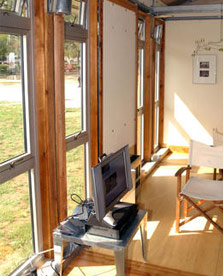

The University of Texas team took advantage of natural daylighting in their 2002 Solar Decathlon house.
Solar Decathlon 2005
Lighting
(100 Points)
Electric lighting is the third largest consumer of energy in buildings. Increasing your lighting efficiency is one of the fastest ways to decrease energy bills. If you replace 25% of lights in high-use areas with fluorescents, you can save about 50% on your lighting energy bill.
To win this contest, teams will have to supply ample interior lighting with as little energy as possible. As with other contests, Lighting is designed to reproduce many elements of real world living. For example, there should be sufficient levels of light in the kitchen and home office work areas, and exterior lighting should illuminate the house numbers and doors all night for increased safety.
Teams will also need to effectively use lighting techniques such as daylighting, which is simply using natural daylight from the sun to illuminate the homes' interiors and reduce energy consumption. However, with sunlight comes heat, which can increase the houses' interior temperatures and reduce the teams' scores in Comfort Zone. The teams will have to carefully consider such design tradeoffs as they design their lighting systems.
Teams can score points in numerous ways, but this contest judges the amount of illumination supplied by both electric lights and daylighting. Lighting levels in each room of a team's house are continuously monitored and recorded. If a house maintains lighting levels within an optimal range, full points are awarded. Teams can also earn points from a panel of judges that will subjectively evaluate the teams' lighting designs, which are required to integrate both electric and natural light, from both a functional and an aesthetic standpoint.
